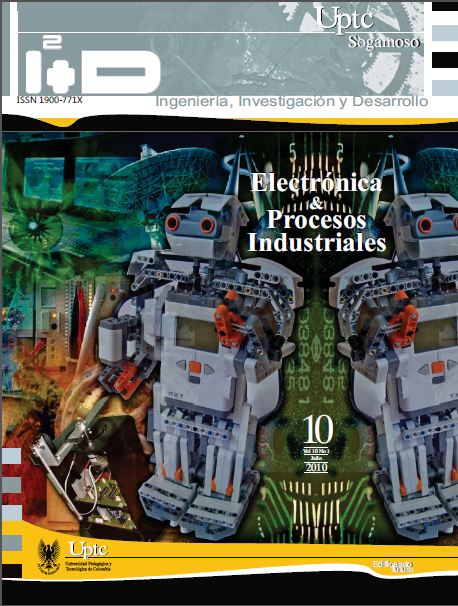Modelo discreto para sistemas de estructura variable

Resumen
En este artículo se presenta un modelo discreto genérico para sistemas de estructura variable. El modelo es aplicado a cualquier sistema de estructura variable de operación cíclica, como convertidores de potencia. Se asume que la frecuencia de conmutación es un múltiplo entero de la frecuencia de muestreo y se emplea retenedor de orden cero. El circuito o el sistema opera en modo cíclico con G posibles configuraciones, el modelo generado es usado en pequeña señal y baja frecuencia, y se valida usando Matlab / Simulink 2007.
Palabras clave
sistema de estructura variable, sistema discreto, frecuencia de conmutación, muestreo de datos, convertidor de potencia, modelo
Citas
- Brown, A. R. and Middlebrook, R. D. (1981): Sampled-data modeling of switching regulators, IEEE Power Electronics Specialists Conf. (PESC) Rec. pages 349-369.
- Burdio, José and Martínez, Abelardo. (1995): A unified discrete-time state-space model for switching converters, IEEE Transactions on Power Electronics, 10(6), pp. 694-707.
- Chen, Chi-Tsong (1999): Linear system theory and design. Oxford University Press, NewYork, 3 edition.
- Fang, Chung-Chieh (1997): Sampled-data analysis and control of DC-DC switching converters, PhD thesis, University of Maryland, Maryland, USA.
- Fossard, A. J. et al. (1977): A general linear continuous model for design of power-conditioning units at fixed and freerunning frequency, IEEE Power Electronics Specialists Conf. (PESC) Rec., pp. 113-124.
- García de Vicuña, J. L. (1990): Modelos discretos no lineales para reguladores continua-continua., tesis de PhD Departamento de Ingeniería Electrónica. Universidad Politécnica de Cataluña, Barcelona, España.
- García de Vicuña, J. L. et al. (1992) Computer-aided discretetime large-signal analysis of switching regulators. IEEE Trans. Power Electronics, 7: 75-82.
- Krein, P. T. and Bass, R. M. (1990) Geometric formulation, classification and methods for power electronic systems. IEEE Power Electronics Specialists Conf. (PESC) Rec. pages 499-505.
- Kislovski, A. S. (1982) General small-signal analysis method for switching regulators. Proc. PCI, pages 1-15.
- Kislovski, A. S.; Redl, R. and Sokal, N.O. (1991) Dynamic analysis of switching-mode DC/DC converters. NewYork, Van Nostrand Reinhold.Lee, F. C. et al. (1979) Generalized computer aided discrete-time modeling and analysis of dcdc converters. IEEE Trans. Ind. Electron. Contr. Instrum, IECI-26: 58-69.
- Louis, J. P. (1983): Non-linear and linearized models for control systems including static converters. Proc. 3rd. IFAC Symp, Control in Power Electronics and Electrical Drives, pp. 9-16.
- Lutz, R. Von y Grotzbach, M. (1985): Straightforward discrete modeling for power converter systems. IEEE. Power Electronics Specialists Conf. (PESC) Rec., pp. 761-770.
- Martinelli, R.M. (1984): A state variable modeling technique for personal computer simulation of converter dynamic properties, Proc. Powercon, 11(H3), pp. 1-9.
- Middlebrook, R. D. and Cuk, S. (1976): A general unified approach to modelling switching- converter power stages., IEEE Power Electronics specialists Conf. Rec., pp. 18- 34.
- Middlebrook, R. D. and Cuk, S. (1977): A general unified approach to modelling dc-to dc converter in discontinuous conduction mode, IEEE Power Electronics specialists Conf. Rec, pages 36-57.
- Ogata, K. (1987): Discrete-time control systems, Prentice Hall, Englewood Cliffs, N.J.
- Prajoux, R.; Marpinard, J. C., et Jalade, J. (1976): Etablissement de modèles mathématiques pour régulateurs de puissance á modulation de largeur d ‘ impulsions (pwm). pti: Modèles discrets. ESASci. Tech. Rev. 2, pp. 25-42.
- Shortt, D. J. and Lee, F. C. (1983): Extensions of discreteaverage models for converter power stages, IEEE Power Electronics Specialists Conf. (PESC) Rec., pp. 23-37.
- Verghese, G. C.; Elbuluk, M. E., and Kassakian, J.G. (1986): A general approach to sampled-data modeling for power electronic circuits, IEEE Trans Power Electronics, PE-1, pp. 77-89.
- Verghese, G. C.; Bruzos, C. A., and Mahabir, K. N. (1989): Averaged and sampled-data modeling for power electronic circuits, IEEE Power Electronics Specialists Conf., (PESC) Rec., pp. 484-491.
- Wood, P. (1979): General theory of switching power converters, IEEE Power Electronics specialists Conf., (PESC) Rec., pp. 3-10.
- Wood, P. (1981): Switching power converters, New York, Van Nostrand Reinhold.
- Yaakov, Sam Ben and Huliehel, Fakhralden. (1991): Lowfrequency sampled data models of switched mode dc-dc converters, IEEE Transactions on Power Electronics, 6(1):55-61.